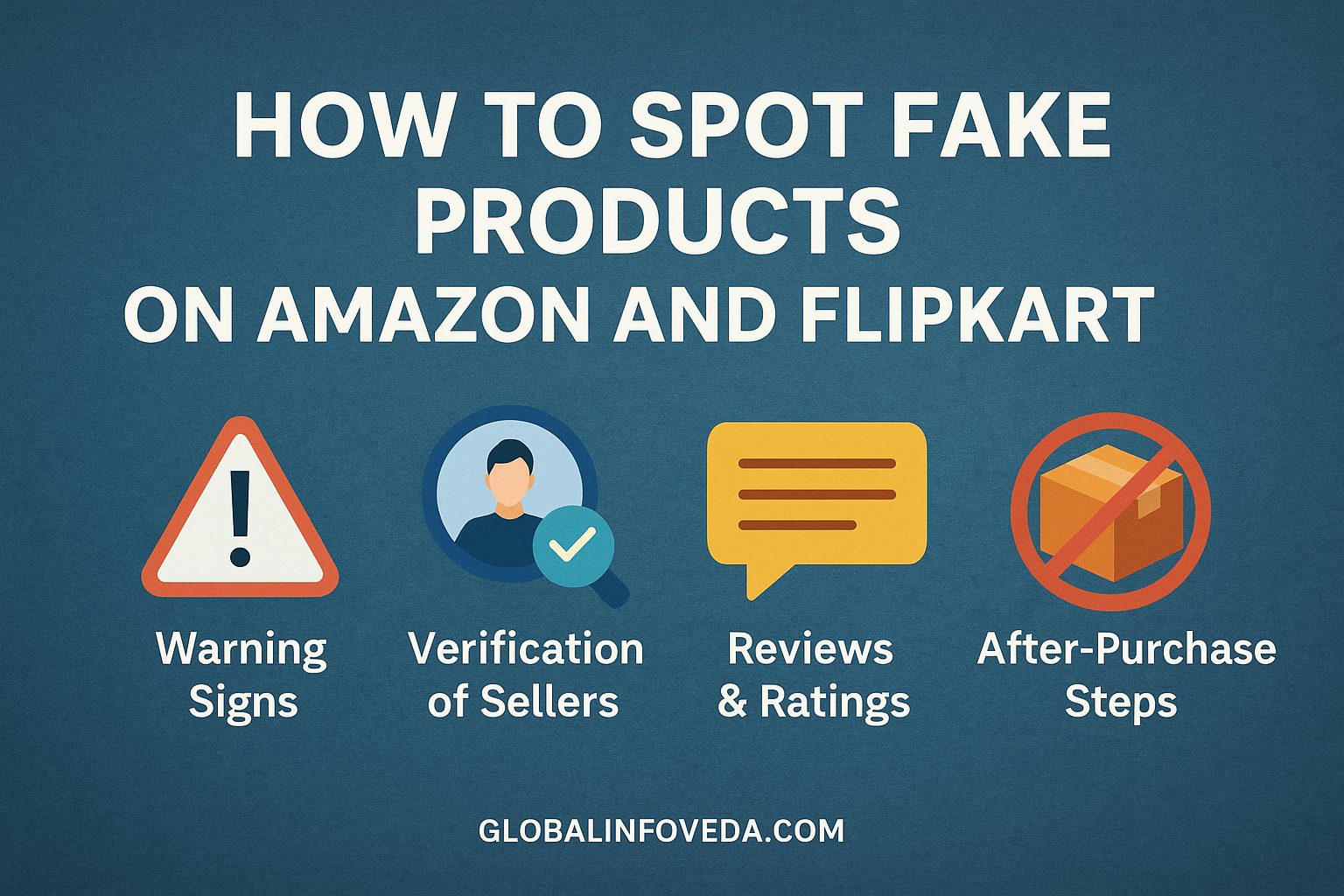Fake Products on Amazon and Flipkart
Online shopping has transformed how we shop—offering convenience, broader choices, and faster delivery. However, with this boom in e-commerce has come a darker side: counterfeit products. These fake items, disguised to mimic genuine brands, can endanger your health, drain your wallet, and erode consumer trust. Platforms like Amazon and Flipkart work hard to filter these out, but they occasionally slip through. Here’s a comprehensive guide to help you shop smarter, safer, and with confidence.
🛑 Why Spotting Fakes Is Important
Understanding the impact of counterfeits helps prioritize vigilance:
- Health & Safety Risks: Fake cosmetics, supplements, or electronics may contain hazardous materials or pose fire/electrical risks.
- Poor Quality & Durability: Imitations often break quickly, offer subpar performance, and don’t meet quality standards.
- No Warranty or Customer Service: Counterfeit items usually have no support or service after sale.
- Legal Consequences: Supporting counterfeit markets could result in legal action and loss of consumer protections.
- Impact on Brands & Jobs: Fake products damage reputations and undercut legitimate businesses and jobs.
🔍 Signs of a Fake Product
1. Too-Good-to-Be-True Pricing
- Compare with official store pricing. Unreasonably low discounts—especially on new or trending products—signal risk.
- Use price tracker tools like Keepa, CamelCamelCamel, or Flipshope for price history insights.
2. Seller Credentials
- On Amazon:
- Prioritize “Sold by Amazon.in” or “Fulfilled by Amazon” sellers.
- Beware of recently created sellers or those with inconsistent inventory.
- On Flipkart:
- Choose “Flipkart Assured” or sellers with long-standing presence and high feedback scores.
- Click the seller’s name to explore their feedback, return policies, and ratings.
3. Product Reviews & Ratings
- Focus on “Verified Purchase” reviews with photos.
- Check low-rated reviews for recurring complaints about fakes.
- Use third-party review analysis tools:
- ReviewMeta: Adjusts rating by filtering out suspicious reviews
- Fakespot: Grades review reliability using AI
4. Product Packaging & Descriptions
- Review product photos closely:
- Look for missing barcodes, uneven fonts, grammatical errors, or strange spellings
- Legitimate brands often include QR codes, serial numbers, and branding holograms
- Compare technical specifications and model numbers against the brand’s official listing.
5. Brand Presence & Storefront
- Search for the brand’s official store on Amazon/Flipkart.
- Visit the brand’s website to confirm links to its authorized sellers.
- Contact brand support via social media to verify links or seller IDs.
6. Return & Refund Policy
- Read the fine print on returns:
- Avoid sellers that require buyers to ship products internationally or offer partial refunds without return.
- Stick to products eligible for no-questions-asked return windows.
7. Customer Questions & Answers
- Q&A sections can be goldmines for insights.
- Search for the words “original,” “authentic,” or “fake” in the question thread.
- Sellers avoiding clear responses or downplaying questions should raise suspicion.
🧠 Smart Shopping Tips to Avoid Fakes
- Stick to Official Apps and Sites: Only shop from verified platforms and avoid third-party shopping apps with unverified origin.
- Use Filters: Use platform filters like “Amazon Choice,” “Flipkart Assured,” or “Official Brand Stores.”
- Search by Brand Name: Avoid re-typed or misspelled brand listings that mislead shoppers (e.g., “Adibas” instead of “Adidas”).
- Use 2-Factor Authentication (2FA): Protect your e-commerce accounts with 2FA.
- Track Order History Closely: On delivery, inspect the product and packaging before unsealing. Use unboxing videos as proof.
- Request GST Invoices: Always request official invoices for high-value items for warranty claims.
📝 What to Do If You Buy a Fake Product
- Report the Listing Immediately
- Amazon: Click “Report Incorrect Product Information” or raise a case via chat/call.
- Flipkart: Use the “Report Infringement” or “Need Help” features.
- Initiate a Return or Replacement
- Choose the “Received counterfeit item” reason for return.
- Attach photographic evidence showing differences from original product.
- Leave an Honest, Detailed Review
- Include packaging photos and side-by-side comparisons if possible.
- Describe your experience and how you confirmed the item was fake.
- Contact the Brand for Authentication
- Share serial numbers, photos, or invoices. Brands can often confirm legitimacy.
- Raise a Complaint with Consumer Authorities
- National Consumer Helpline (India): 1800-11-4000 or consumerhelpline.gov.in
- Escalate unresolved cases to e-commerce grievance cells or brand legal departments.
🛡️ Bonus Tips: High-Risk Categories
Certain product categories see more counterfeiting than others:
- Electronics & Accessories: Headphones, chargers, phone cases, smartwatches
- Beauty & Skincare: Lipsticks, creams, serums, imported makeup
- Nutritional Supplements: Protein powders, vitamins, weight loss pills
- Footwear & Apparel: Sneakers, sports gear, luxury brands
- Watches & Jewelry: Imitation accessories are rampant in fashion categories
Always double-check product authenticity in these segments using QR code scans, holograms, and seller details.
🔐 Stay Informed, Shop Smart
The convenience of online shopping should not come at the cost of quality or safety. Counterfeiters are becoming more sophisticated—but so can you. With informed decisions, the right tools, and a careful eye, you can shop confidently on Amazon and Flipkart.
Don’t compromise on safety or standards—verify before you buy.
🌐 For more online safety tips, consumer protection advice, and product reviews, visit GlobalInfoVeda.com
